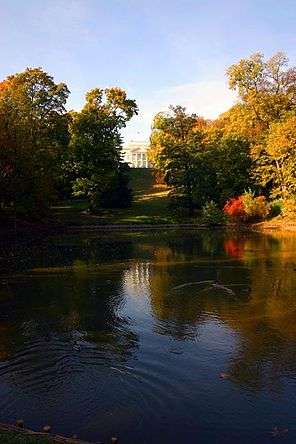Belweder
| Belweder Palace Pałac Belwederski (Polish) | |
|---|---|
|
Belweder Palace (view from ulica Belwederska). | |
| General information | |
| Architectural style | Neoclassical |
| Town or city | Warsaw |
| Country | Poland |
| Construction started | 1660 |
| Completed | 1819–1822 |
| Client | Krzysztof Zygmunt Pac, Grand Duke Constantine, Józef Piłsudski |
| Design and construction | |
| Architect | Jakub Kubicki (1819–1822) |

Belweder (Polish pronunciation: [bɛlvɛdɛr]; in full Pałac Belwederski, Belweder Palace, from the Italian belvedere) is a palace in Warsaw, near the Łazienki Park. It was used as an official residence by the Polish presidents.
History
The present building is the latest of several that stood on the site since 1660.[1] Belweder once belonged to Poland's last king, Stanisław August Poniatowski, who used it as a porcelain-manufacturing plant.[2] From 1818 it was the residence of Russian Grand Duke Constantine, who fled it at the beginning of the November 1830 Uprising.[2]
After the re-establishment of Poland's independence following World War I, it was (with a hiatus, 1922–26) the residence of Marshal Józef Piłsudski,[2] Chief of State (1918–22) and later (1926–35) Minister of Military Affairs of Poland, who died there in 1935. (During the May 1926 coup d'état, President Stanisław Wojciechowski had abandoned it ahead of Piłsudski's advancing forces.)
During World War II, the building was extensively remodeled for Hans Frank, Governor of the "General Government" of Poland. It remains one of the few original structures in Warsaw to survive World War II.
In 1945-1952 it was the residence of Bolesław Bierut, and later of the president of the Council of State. From 1989 to July 1994, it was the official residence of Poland's presidents (Wojciech Jaruzelski and Lech Wałęsa), but proved too small for that purpose. Later on president Bronisław Komorowski used it as his private residence.
Belweder is normally used by the President and the government for ceremonial purposes, while the President resides at the "Presidential Palace" in the city center. It also serves as an official residence for heads of state on official visits to Poland and other important guests. There have been plans to turn the Belweder Palace into a museum dedicated to Józef Piłsudski. Currently it houses a small exhibition devoted to the Marshal.[2]
Gallery
-

Façade of the palace
-
.png)
Łazienki Park in 1775 by Bernardo Bellotto
-

Storming of the Belweder Palace during the November Uprising
-
Statue of Józef Piłsudski in front of the Belweder, Piłsudski's residence
See also
- Royal Route
- Presidential Palace
- Polish classicism
- Belvedere Vodka - a brand named after the palace, which is depicted on its label
References
- ↑ "Belweder". www.warsawtour.pl (in Polish). Retrieved 2009-03-23.
- 1 2 3 4 "Belvedere". eGuide / Treasures of Warsaw on-line. Retrieved 2009-03-23.
External links
| Wikimedia Commons has media related to Belweder. |
- Belweder, or the Polish road to independence
Coordinates: 52°12′47″N 21°01′40″E / 52.21306°N 21.02778°E
